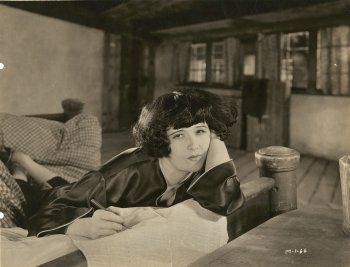Researching silent actresses, particularly more minor ones, can be a nuisance. Many of the pages online about them are copies of one another—possibly the Wikipedia page came first, or possibly one of the others did and the Wikipedia page is copied from that, and at this stage who even knows? Margaret Livingston’s face is familiar; many of her costars don’t even have that. After all, Livingston was in at least one genuine classic—to my mind, as a Clara Bow fan, more than that. Many, many movies get made, and many, many people get forgotten over the years.
Legend has it that her interest in becoming an actress was truly piqued by meeting Edna Purviance, one of Charlie Chaplin’s leading ladies, in a shop and seeing her drop about a week’s wages on a bottle of perfume. In 1916, she appeared in The Chain Invisible. Some of her credits are as Marguerite, which apparently does appear on her birth certificate, but mostly she was listed as Margaret. She was in a few dozen silents, any number of which are now considered lost, and made the transition to talkies fairly adeptly.
Livingston was already making sound films when she dubbed Louise Brooks in The Canary Murder Case, when it was made over from being silent and Brooks had no interest in doing the work involved in voicing her character. She’s one of the people whose voice was well suited to it. She was in Clara Bow’s Call Her Savage and Smart Money with Edward G. Robinson. She made a couple of dozen or so sound pictures all told. She’s the biggest name in many of them to modern eyes, though she is seldom as high as second-billed.
In 1931, she married Paul Whiteman and retired from the screen. She wrote a book about the diet she’d put her husband on. She adopted four children with Whiteman. She invested in real estate and oil and seems to have been quite an astute businesswoman. She lived some fifty years after her last film, and if she regretted having walked away from Hollywood, no one seems to have written about it. Her husband seems like a fine, jovial fellow who announced shortly before he died that, were he new to music in those days, he would grow his hair long and get into rock and roll.
In November 1924, Margaret Livingston went for a weekend trip on the Oneida, the yacht owned by William Randolph Hearst. If she actually was there as Thomas Ince’s lover, I’m unaware of any evidence about it, but that’s certainly the claim. At any rate, she was there that ill-fated weekend. She was one of the ones who knew what had happened—whether she was sharing a cabin with Ince or not, she presumably would have been aware of at least something. I also feel as though some of those people would have talked to each other, if no one else, because they had to talk about it to someone.
Honestly, $18 for a bottle of perfume is out of my current budget; help me out by supporting my Patreon or Ko-fi!

